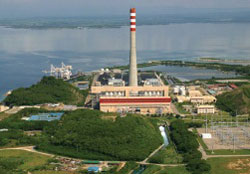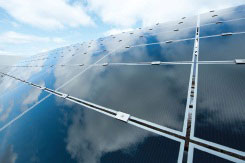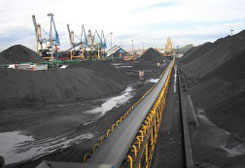Asia’s quest for clean energy
Also, download this story from the electronic issue here
The pressure to shift to clean energy may be too soon for Asia that is clinging on to more non-renewables in its energy mix, says Angelica Buan in this report.
Thailand and Indonesia giant consumers
Economies in Asia rely heavily on energy to power industries. The ASEAN’s total energy consumption increased by 4% in 2013, with Thailand and Indonesia accounting for 58% of the consumption share in 2013, according to Franceheadquartered consulting firm Enerdata.
This growing demand, which augurs well for the energy sector, is at the same time straining the environment, especially since energy is sourced mostly from non-renewables. On the other hand, this awareness that it is just a matter of time before non-renewables are exhausted is setting forth the direction to utilising renewable energy sources, which are cleaner, in virtually abundant supply, and cost-efficient.
According to research from US-headquartered consultancy Pew Charitable Trusts (PCT), investments in clean energy are growing. It finds that the scale and scope of investments in and deployment of renewable energy are expanding in emerging economies at the back of “national economic development goals, local priorities for the environment and health, and international cooperation to reduce global energy poverty”
And whilst in the five-year duration of the research, with economy defining situations such as global recession, changing energy markets and ontogeny of international policies on renewables and climate change, the clean energy sector has become a US$300 billion fixture of the world economy.
PCT estimated that US$62 billion worth of energy investments from 2009 to 2013 are occurring in non-G20/Organisation for Economic Cooperation and Development (OECD) countries. Almost 45% of this figure or US$27.9 billion occurred in ten emerging markets where clean energy capacity leapt by 91% within the five year-period. Five of these emerging markets are in the East and Southeast Asia: Taiwan, Vietnam, Pakistan, and the Philippines; with Thailand taking the lead.
Developing countries are betting on solar, wind, biomass, geothermal, biofuels and other renewable energy sources in order to alleviate energy poverty, promote power economic progress, reduce imports, and protect the environment, according to PCT.

Amidst the growing allocation for clean energy capacity, fossil fuel-based energy still dominates installed energy capacity or 67% of the total energy capacities, in the top ten emerging markets. Nonetheless, installation for conventional fossil fuel-powered plants has somewhat downsized by less than 10% from the period studied, said PCT.
Fossil fuels, including coal, oil and natural gas, provide the world’s energy needs. Coal is a widely used power source and is cheaper. According to coal statistics of the World Coal Association (WCA), coal contributes around 30.1% to the global primary energy requirement, and produces over 40% of the world’s electricity.
Asian coal rush
Asia is one region where coal is still widely used evidenced by new coal-fired plants being opened. Citing a sector forecast published by US-headquartered market researcher McIlvaine Company, Asia will be generating 1,464,000 megawatts (MW) of coal-fired power by 2020, up from 918,000 MW in 2013, which would translate to a CO2 spike of 2.6 billion tonnes.
The 2014 World Energy Outlook of the Energy Information Agency (EIA) noted that coal trade will expand by 40% to 2040, driven by strong Asian demand.
However, emerging climate change policies are hampering this demand growth in the main markets of the US, China and Europe. Despite this, coal use continues and in Asia, the demand is brisk. Coal production is also starting to shift to the region to India. China, India, Indonesia and Australia will account for over 70% of global coal output by 2040, the IEA report cited.
Aligning with its campaign to mitigate air pollution, China is easing up on coal use. China’s heavy utilisation of coal-fired plants to generate electricity has taken a toll on its air quality, especially in big cities and industrial areas. The country has also been blamed as the biggest contributor to global warming. The antipollution drive affected coal output and sales, declining nearly 6% year-on-year to almost 1.8 billion tonnes in the first six months of the year according to data report from the Beijing-based National Development and Reform Commission (NDRC).
The opposite effect is unfolding in other countries in the region. For example, the Philippines’s Department of Energy (DOE) reported that new coal-fired power plants will come on stream starting next year. By 2020, there will be 25 new plants in operation, it said. Nonetheless, renewable energy share will also be increased by 30% from the current 23%; and liquefied natural gas (LNG) would account for a 30% share in the energy mix. Likewise, a feedin- tariff (FIT) scheme is also being implemented with the deployment of renewable energy.
Thailand, rattled by nearly depleting natural gas reserves, is also opening new coal plants to sustain its energy security. In a 2010 IEA Clean Coal Centre publication, Thailand’s proven gas reserves, which make up a third of the country’s gas supply, were projected to last for only 12 years. The nation’s Power Development Plan (PDP) has been amended to focus on coal as a primary power generation source. The amendment would involve, among others, minimising the use of natural gas to generate power from 64% to 40%; and increase coal use from 20% to 25%, and renewable energy from 8% to 20%.
Indonesia, whose power demand has been projected to grow at an average of 7.4% annually over the short to medium term, is also pushing up installed capacity from the approximately 40 GW projected in the UK-based firm PricewaterhouseCoopers (PWC) taxation guide report published in 2013. It said that the Indonesian government plans to more than double capacity by 2020.

The international environmental group, Greenpeace, in its 2014 briefing paper cited that some 117 new coal-fired power plants are planned to be developed in Indonesia. Recently, the country has presented its imminent plan of adding 42 GW power capacity to its current 53 GW by 2024; and an allocation of an estimated US$90.1 billion for the plant projects by state-owned electricity producer Perusahaan Listrik Negara (PLN) and private firms. Reportedly half of the planned additional capacity or 20 GW will be obtained from coal-fired plants. Coal production is forecast to reach 400 million tonnes by 2019.
Vietnam’s demand for coal is also growing and it is pumping up investments into this sector. The country’s Power Master Plan VII highlights the critical role of coalfired thermal power facilities in its energy agenda. It stated that these plants are projected to generate 46.8% or 36,000 MW of the country’s total electricity output by 2020, further rising to 56.4% or 75,000 MW by 2030. This is not surprising as Vietnam is a major coal producer that supplies both domestic power plants and countries in the Asia Pacific region.

A “dirty” stigma
Coal may be the cheapest (so far) source of power for manufacturing plants yet it has earned the stigma of being a “dirty energy” source. Why is that so?
Generating electricity from coal commonly involves burning of the coal in power plants to produce steam that converts to energy when run through turbines.
The US Environmental Protection Agency (EPA) listed on its website the environmental impacts of coal-fired power plants from the time the coal is mined to when it is converted to energy. EPA explains that burning coal generates emissions in the environment. Related activities such as mining, cleaning and transporting coal to the power plants also give off additional emissions. Power plants also need large amounts of water for producing steam and for cooling.
The plants will then discharge the polluted water into lakes or rivers. Burnt coal also creates ash that is composed of metal oxides and alkali. Much of this solid waste ends up in landfills or abandoned mine sites. As well, the coal-fired power plant could contaminate the soil within its peripheries.
The US-based Union of Concerned Scientists (UCS) is emphasising on solutions that are cleaner to meet the world’s energy needs without jeopardising the environment. The group is batting for increasing renewable energy and decreasing coal use. On its website, it describes coal as “our dirtiest source of energy,” because, it said, coal releases more pollutants into the atmosphere than any other energy source and is responsible for about 25% of the US’s global warming emissions.
UCS strongly backs policies that promote renewable energy, including adoption of strong renewable electricity standards, clean energy tax credits (and similar financial incentives), and investment in smarter electrical grids. Likewise, it is pushing for the shutting down of the “oldest, dirtiest coal plants” and to not replace these by opening new coal plants to address air pollution and global warming.
However, there are new advances in coal technologies that produce “clean” coal, according to the World Coal Association or WCA. The “supercritical” and “ultra-supercritical” technologies not only improve coal power efficiency but also reduce GHG emissions by up to 3%.
Others are the carbon capture and storage (CCS), which by far is the most widely used of these new clean coal technologies, while the underground coal gasification (UGC) enables the otherwise unrecoverable coal resources with fewer GHG emissions to be utilised. Lastly, coal to liquid fuels (CTL) and synthetic natural gas (SNG) can provide “clean” liquid fuels.
Renewables to take over
Over the next two decades, the majority of the world’s new power generation infrastructure, comprising a mix of fossil fuel-based and cleansourced powers, is anticipated to rise in Asia. An estimated US$3.3 trillion investment for new power generation is projected in China, according to the research group Bloomberg New Energy Finance (BNEF) in its report.
What’s more, the cost for renewables is declining. Wind power is expected to be the cheapest form of new power generation worldwide by 2026, while solar panel projects would reach utility-scale by 2030.
To sustain the impetus for clean energy, the Asian Development Bank (ADB) has launched a clean energy development initiative for the region and is the region’s largest financier for clean energy. In 2014, the Manila-headquartered agency’s own financing reached over US$2.4 billion.
At the Asia Clean Energy Forum held in June, Bindu N. Lohani, ADB Vice-President for Knowledge Management and Sustainable Development Renewables, said that the utilisation of renewables is becoming more competitive considering that technology is advancing, yet the region has not fully maximised its potentials, amidst a large population still wanting access to electricity.
He said that dependency on fossil fuel remains high that the region’s annual CO2 emissions register at 13.4 billion tonnes, or 37% of global emissions. The region’s clean energy investment reached nearly US$106 billion in 2013.
Another programme was launched early this year that highlights clean energy in the region. The Overseas Private Investment Corporation (OPIC), the US Department of State, and the US Trade and Development Agency (USTDA) launched the Asia-Pacific Clean Energy Program under the US-Asia Pacific Comprehensive Energy Partnership (USACEP). The consortium, together with the US Export-Import Bank, have allotted US$6 billion in financing resources to meet the region’s need for approximately US$9 trillion in energy investments by 2035.
LENR: a fresh option
The transition from the so-called dirty to clean energy status may take some time, according to findings from Bloomberg New Energy Finance or BNEF. It projected that by 2040, more than half the world’s energy would have come from cleaner sources, with 46% of global electricity generated by clean energy, top billed by wind turbines and solar panels.
Not oft-mentioned but nevertheless it offers insurmountable clean energy potential is the Ultralow Energy Neutron Reactions (LENR). Like many other clean energy platforms, it has been undercommercialised.
“The LENR technology, if successfully commercialised and scaled-up, could potentially replace fossil fuels in the not-too-distant future (over a period of 20-40 years) because it would be CO2-free and significantly less costly for consumers and businesses,” said Lewis G. Larsen, CEO/President of Chicago-based Lattice Energy LLC in an interview with PRA.
When asked if LENR is a viable alternative to fossil fuels (as an energy source), he replied, “LENRs are much more synergistic than competitive fossil fuels such as oil and coal.”
Larsen, who has been involved in developing the technology since 1997, said that LENRs are a “truly biosafe nuclear technology that involves neither fission nor any kind of fusion process, hot, cold, warm, or otherwise.”
He explained the “clean energy” potentials of this technology in various applications. “LENRs’ uniquely green attributes would also enable the future development of revolutionary, compact battery-like portable nuclear power sources that could compete directly with chemical batteries and fuel cells in many high-performance applications that include portable electronic devices like power tools, tablet computers, and smartphones,” he said.
How can emerging and underdeveloped nations in the Asian region benefit from LENRs? “At system power outputs of just 5-10 kW, green LENR-based distributed CHP power generation systems providing heat and electricity could potentially satisfy the requirements of a majority of urban and rural households and smaller businesses throughout Asia. For system power outputs of just 50-200 kW thermal, LENRbased systems could begin to power steam or electric vehicles, breaking oil’s stranglehold on transportation; as well as provide high-quality heat for industrial processes.”
Nevertheless, as with other new technologies, deployment is an issue.
“Small-scale LENR systems might seem to be light years away from being able to compete headon with enormous 500-1,000 MW coal-fired and Uranium-fission power plants,” said Larsen, adding that it is not a remote possibility that commercial versions of LENR technologies could begin competing directly with coal, oil, and natural gas as a cost-effective CO2-free primary energy source.
“If grid-scale LENR-based power plants were built, there is an excellent chance that they might be around 54-74% less expensive than natural gas,” he claims.
Currently, R&D efforts on LENR are being carried out in countries like the US, Japan, China, Ukraine, and the EU.
Larsen said that he is mulling expansion to Asia in the future. “Someday, we would like to second-source, licence, and/or partner with Asian companies,” he adds.
(PRA)Copyright (c) 2015 www.plasticsandrubberasia.com. All rights reserved.









































